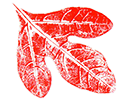The eastern red bat (Lasiurus borealis) is a common bat throughout much of the eastern U.S. It is one of our larger bats at approximately 4-5 inches long. The wingspan of a red bat is between 11 and 13 inches or approximately twice the length of a dollar bill. As their name suggests, they are a reddish color which can range from a bright orange-red to a dull, brownish red. Males tend to be darker in color and females tend to be lighter in color.

Like other bats, red bats are active from dusk to dawn. Red bats can often be seen foraging in the early evenings over roads, over ponds, along forest edges, or around street lights. If the light is right, you can sometimes catch flashes of their reddish brown fur as they fly. There is only one other bat in this region that is a reddish brown and it isn’t very common. So, if you catch a glimpse of a reddish brown color on a bat, then it is most likely a red bat.
Red bats eat a variety of insects, but moths make up a large percentage of their diet. (Many of the moths they eat are considered agricultural pests.) Sometimes red bats will catch an insect in their mouth as they fly, but often they will first scoop the insect up in their wing or tail membrane and then grab it in their mouth – all while still flying.
During the day, red bats roost by themselves among the leaves of trees. They’ll grab a branch or twig with one foot and curl up with their furry tails wrapped around them. In this position, they are surprisingly well camouflaged and can easily be mistaken for a clump of dead leaves. Being able to look like a clump of dead leaves is a good thing, because blue jays, opossums, and some birds of prey will eat red bats if they find them. It is rare to find a red bat in a cave or to see more than one red bat roosting in a spot.
Much is still unknown about the hibernation patterns of red bats. Many red bats, especially in northern areas, will migrate to more southern regions for the winter. In Kentucky, some of our red bats will hibernate in hollow trees or logs, in the leaf litter at the base of trees, or under loose bark instead of migrating. You can sometimes see them foraging on warm winter evenings.
Red bats breed in August and September; however, the female will store the sperm and won’t become pregnant until the spring. The babies, called pups, are born in May or June. When they are born, the pups are blind and hairless. Most bat species will only give birth to a single pup each year, but red bats will have litters of 2-5. The pups typically start flying when they are four or five weeks old and are weaned shortly after that.
Although bats often get a bad rap, they actually play a very important role in the ecosystem. They can often be found flying over our backyards, parks, and other human-built landscapes as well as more natural areas. So next time you are out in the early evening or early morning, look up and see if you can see any bats flying around. If you’re patient, you may even catch a glimpse of red that will allow you to identify the bat you are watching.

This article was part of Shannon’s original Kentucky Pollinators and Backyard Wildlife blog which evolved into the blog for Backyard Ecology.

Backyard Ecology: Exploring Nature in Your Backyard
Nature isn’t just “out there.” It’s all around us, including right outside our doors. Hi, my name is Shannon Trimboli, and I am the host of Backyard Ecology. I live in southcentral Kentucky and am a wildlife biologist, educator, author, beekeeper, and owner of a nursery specializing in plants for pollinators and wildlife conservation. I invite you to join me as we ignite our curiosity and natural wonder, explore our yards and communities, and improve our local pollinator and wildlife habitat. Learn more or subscribe to my email list at www.backyardecology.net.

Leave a Reply